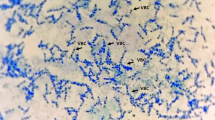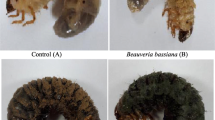Abstract
Screening for spore-forming bacteria to use against dipterous insects, namelyMusca domestica, Aedes aegypti andCulex pipiens from Egypt, led to two isolates, M1 and S128, being found which were highly toxic to bothAedes andCulex strains. They had calculated international Toxicity Units (ITU) valdes of 17,467 and 20,065 ITU/mg, respectively, as compared with 15,000 ITU/mg forBacillus thuringlensis H-14 IPS-82 Reference Standard. They were taxonomically classilled asBacllus thuringlensis H-14. Their sensitivity to a number ofBacillus phages is also described.
Résumé
Le criblage pour des bactéries sporulantes à utiliser contre des insecles diptères, notammentMusea domestica, Aedes aegypti, etCulex pipiens d'Egypte, a conduit à deux isolats, M1 et S128, dont on a montré la forte toxicité tant pour des souches deAedes que deCulex. Elles avaient des valeurs calculées d'Unités Internationales de Toxicité (UIT) respectivement de 17 467 et de 20 065 UIT par mg, ce qu'il faut comparer aux 15 000 UIT par mg chezBacillus thurigiensis H-14, standard de référence IPS-82. On les a classifiées sur le plan taxonomique commeBacillus thurigiensis H-14. On décrit également leur sensibillté à un certain nombre de phages deBacillus.
Similar content being viewed by others
References
Barjac, H. de 1978 A new subspecies ofBacillus thuringiensis very toxic for mosquitosBacillus thuringiensis var.israelensis serotype 14.Comptes Rendus Hebdomadaires des Seances de l'Académie des Sciences (Paris), Série D 286, 797–800.
Barjac, H. De 1981 Identification of H-serotypes ofBacillus thuringiensis. InMicrobial Control of Pests and Plant Diseases, ed. Burges, H.D., pp. 35–43. London: Academic Press.
Barjac, H. De, Sisman, J. &Cosmoa Dumanoir, V. 1974 Description de 12 bactériophages isolés a partir deBacillus thuringiensis.Comptes Rendus Hebdomadaires des Seances de l'Académie des Sciences (Paris), Série D 279, 1939–1942.
Berkeley, R.C.W., Logan, N.A., Shute, N.A. &Capey, A.G. 1984 Identification ofBacillus species.Methods in Microbiology 16, 292–328.
Buchanan, R.E. &Gibbons, N.E. (eds) 1974Bergey's Manual of Determinative Bacteriology, 8th edn, p. 536. Baltimore, MD: Williams & Wilkins.
Carlberg, G. 1973 Biological effects of thermostable exotoxin produced by different serotypes ofBacillus thuringiensis.Reports from the Department of Microbiology, University of Helsinki 6, 1–90.
Carlberg, G. 1986Bacillus thuringiensis, and microbial control of flies.MIRCEN Journal of Applied Microbiology and Biotechnology 2, 267–274.
Dulmage, H.T. 1971 Production of δ-endotoxin by 18 isolates ofBacillus thuringiensis serotype 3, in 3 fermentation media.Journal of Invertebrate Pathology 18, 353–358.
Goldberg, L.J. &Margalit, J. 1977 A bacterial spore demonstrating rapid larvicidal activity againstAnopheles sergentii, Uranotaenia unguicultata, Culex univitattus, Aedes aegypti, andCulex pipiens.Mosquito News 37, 355–358.
Hall, I.M., Arakawa, K.Y., Dulmage, H.T. &Correa, J.A. 1977 The pathogenicity of strains ofBacillus thuringiensis to larvae ofAedes aegypti and toCulex mosquitoes.Mosquito News 37, 246–251.
Ignoffo, C.M., Hostetter, D.L., Pinnell, R.E. &Garcia, C. 1977 Relative susceptibility of six soybean caterpillars to a standard preparation ofBacillus thuringiensis var.kurstaki.Journal of Economic Entomology 70, 60–65.
Lüthy, P., Cordier, J. &Fisher, H. 1982Bacillus thuringiensis as a bacterial insecticide: basic considerations and applications. In:Microbial and Viral Pesticides, ed. Kurstak, E., pp. 35–74. New York: Marcel Dekker.
Mulligan, F.S., III, Schaefer, C.H. &Wilder, W.H. 1980 Efficacy and persistance ofBacillus sphaericus andBacillus thuringiensis H-14 against mosquitoes under laboratory and field conditions.Journal of Economic Entomology 73, 684–688.
Rogoff, M.H., Ignoffo, C.M., Singer, S., Gard, I. &Prieto, A.P. 1969 Insecticidal activity of thirty-one strains ofBacillus against five insect species.Journal of Invertebrate Pathology 14, 122–129.
Smirnoff, W.A. 1962 A staining method for differentiating spores, crystals, and cells ofBacillus thuringiensis (Berliner).Journal of Insect Pathology 4, 384–386.
Author information
Authors and Affiliations
Rights and permissions
About this article
Cite this article
Abdel-Hameed, A., Carlberg, G. & El-Tayeb, O.M. Studies onBacillus thuringiensis H-14 strains isolated in Egypt—I. Screening for active strains. World J Microbiol Biotechnol 6, 299–304 (1990). https://doi.org/10.1007/BF01201301
Received:
Revised:
Accepted:
Issue Date:
DOI: https://doi.org/10.1007/BF01201301




